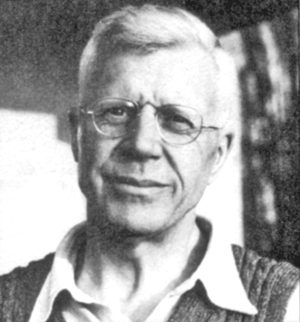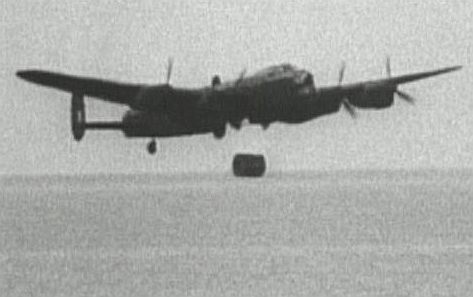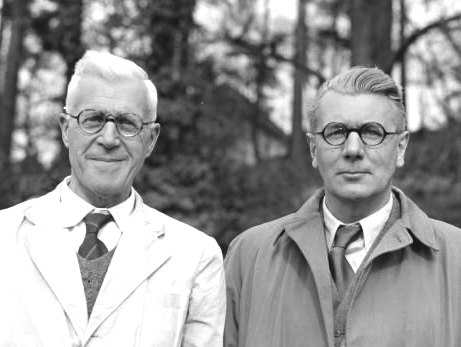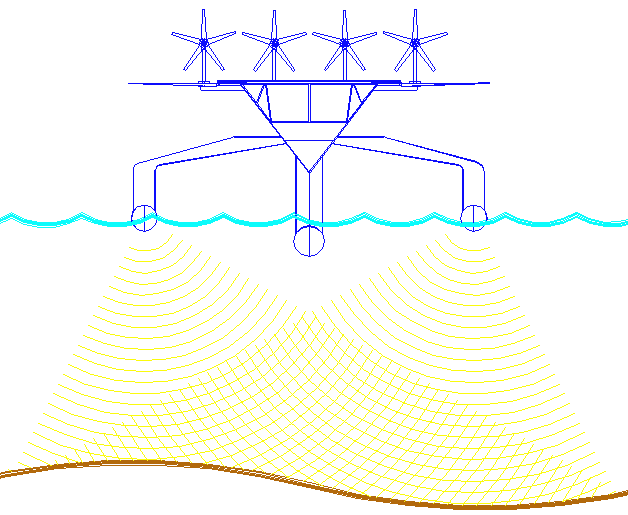|
Sir
Barnes Neville Wallis, CBE, FRS, RDI, commonly known as Barnes
Wallis, (September 26, 1887 – October 30, 1979) was a British
scientist, engineer and inventor.
He is best known for inventing the bouncing
bomb used by the RAF
in Operation Chastise (the Dambusters Raid) to attack the Möhne and
Eder dams in the Ruhr area in May 1943, during the Second
World War.

Sir
Barnes Neville Wallis
Biography
Barnes
Wallis was born in Ripley, Derbyshire and educated at Christ's Hospital
School in Horsham, leaving school at sixteen to start work in a
shipyard. He originally trained as a marine engineer but turned his hand
to airship design and then aircraft design. He worked for Vickers and
its successor companies (including British Aircraft Corporation) from
1913 until his retirement in 1971.
His
many achievements include the first use of geodesic design in
engineering, in the gasbag wiring of the R100, in 1930 the largest
airship yet designed. He also pioneered the use of light alloy and
production engineering in the structure design of R100. Despite a
better-than-expected performance and a successful return flight to
Canada in 1930, the R100 was broken up following the tragedy that befell
its "sister" ship, the R101 (which was designed and built by a
separate Government-led team); the later crash of the Hindenburg led to
the abandonment of airships as a mode of mass transport. (Wallis was not
involved with either of these airships.)
Wallis's
pre-war aircraft designs included the Vickers Wellesley and the Vickers
Wellington, both also employing a geodesic design in the fuselage and
wing structure. The latter was one of the most robust airframes ever
developed, and pictures of its skeleton largely shot away, but still
sound enough to bring its crew home safely, still astonish today. The
geodesic construction offered a light and strong airframe (compared to
conventional designs) with clear space within for fuel tanks, payload
etc.

Lancaster
bomber dropping bouncing bomb
On
1 September 1939, Germany invaded Poland and the Second World War began.
Wallis saw a need for strategic bombing to destroy the enemy's ability
to wage war, leading him to develop the bouncing bomb, immortalised in
the Paul Brickhill's 1951 book The
Dam Busters and the 1954 film with the same name. Wallis
designed the Tallboy (6 tonnes) and Grand Slam (10 tonnes) deep
penetration ("earthquake") bombs used to attack V1 rocket
launch sites, submarine pens, and other reinforced structures, as well
as the Tirpitz battleship. These two bombs were the fore-runners
of modern bunker-busting bombs, and could enter the earth at supersonic
velocity. The Tallboy should not be confused with the 5 tonne
"blockbuster" bomb, which was a conventional blast bomb.
Wallis first superlarge bomb design came out at some ten tonnes, far
larger than any current plane could carry. This led him to suggest a
plane that could carry it, the "Victory bomber", rather than
drop the idea.
Wallis
did much pioneering engineering work to make the swing-wing concept
functional (though he did not invent the concept). However, despite very
promising wind tunnel and model work, his designs were not taken up. His
early Wild Goose (late 1940s) hoped to use laminar flow, but when this
was shown to be unworkable, he developed swing-wing further for the
Swallow (mid 1950s) which could have been developed for either military
or civil applications. The UK government instead adopted the BAC TSR-2
(which Wallis did not work on, though one of his sons did) and Concorde.
The BAC TSR-2 project was ignominiously scrapped in the mid 1960s in
favour of the American F-111 (which had swing wings), though this order
was also subsequently cancelled.
Wallis
also proposed using large cargo submarines
to transport oil undersea, hence avoiding surface weather conditions.
This idea was put into practice on a tactical level by the Germans, with
their milch cows.
During
the 1960s and into his retirement, he developed ideas for an
"all-speed" aircraft, capable of efficient flight at all speed
ranges from subsonic to hypersonic.
The
story described in The Dam Busters reflected a trend throughout
his lifetime, that his ideas were rejected by those in authority (and
who controlled funding sources).
Following
the terrible death toll of the aircrews involved in the Dambusters raid,
he made a conscious effort never again to endanger the lives of his test
pilots. He also became a pioneer in remote control of aircraft.
Wallis
became a fellow of the Royal Society in 1945 and was knighted in 1968.
Wallis
appears as a fictionalized character in Stephen Baxter's The Time
Ships - the authorised sequel to The Time Machine. He is
portrayed as a British engineer in an alternate history, where the First
World War does not end in 1918, and Wallis concentrates his energies
on developing a machine for time travel. As a consequence, it is the
Germans who develop the bouncing bomb.

Barnes
Wallis and Michael Redgrave 1954
617 Squadron
- the Dambusters
No. 617 Squadron of the Royal Air Force is better known as the "Dambusters" squadron. It currently operates the Tornado GR4 from RAF Lossiemouth,
Scotland.
History
Second World War
The squadron was formed at RAF Scampton during World War II on March 21, 1943. It included Royal
Canadian Air Force, Royal Australian Air Force and Royal New Zealand Air Force personnel. The squadron was formed for the specific task of attacking three major dams on the Ruhr in Germany: the
Möhne, Eder and Sorpe. The plan was given the codename Operation Chastise and was carried out on 17 May 1943. The squadron had to develop the tactics to deploy Barnes Wallis's "Bouncing bomb".
The original commander of 617 Squadron, Wing Commander Guy Gibson, was awarded the Victoria Cross for his part in the raid. The Squadron's badge, approved by King George VI, depicts the bursting of a dam, in commemoration of Chastise.
After the raid, Gibson was banned from flying and went on a publicity tour. George Holden became Commanding Officer (CO) in July, but he was shot down and killed on his fourth mission with the squadron in September 1943, an attack on the
Dortmund-Ems Canal; he had four of Gibson's crew with him. H. B. "Mick" Martin took command temporarily, before Leonard Cheshire took over as CO. Cheshire personally took part in the special target marking techniques required which went far beyond the precision delivered by the standard Pathfinder units — by the end he was marking the targets from a Mustang fighter. He was awarded the
VC.

Throughout the rest of the war, the Squadron continued the specialist and precision bombing role, including the use of the enormous "Tallboy" and "Grand Slam" ground-penetrating earthquake bombs, on targets such as concrete U-boat shelters and bridges, and the
Dortmund-Ems Canal was finally breached with Tallboys in September 1944.
A particularly notable attack was the sinking of the Tirpitz. Tirpitz had been moved into a fjord in northern Norway where she threatened the Arctic convoys and was too far north to be attacked by air from the UK. She had already been damaged by an attack by Royal Navy
midget
submarines and a series of attacks from carrier-borne
aircraft of the Fleet Air Arm, but both attacks had failed to sink her. The task was given to No. 9 and No. 617 Squadrons, who operated from a staging base in Russia to attack Tirpitz with Tallboy bombs. They damaged her so extensively that she was forced to head south to Tromsø fjord to be repaired. This fjord was in range of bombers operating from Scotland, and from there, in October, she was attacked again, but cloud cover thwarted the attack. Finally on 12 November 1944, the two squadrons attacked
Tirpitz. The first bombs missed their target, but following aircraft scored three direct hits in quick succession. Within ten minutes of the fist bomb hitting the Tirpitz she turned turtle. Both squadrons claim that it was their bombs that actually sank the
Tirpitz. All three RAF attacks on Tirpitz were led by Wing Commander J. B. "Willy"
Tait, who had succeeded Cheshire as CO of No. 617 Squadron in July
1944.
The World War II exploits of the squadron, and Chastise in particular, were described in Paul Brickhill's 1951 book The Dam Busters and a 1954 film.
The definitive work however is considered "The Dambusters Raid" by John
Sweetman, Cassell Military Paperbacks (82,99,2002). It is based on careful research and cross checking of original documents as well as interviews with survivors of the raid.
In 2006, it was announced that New Zealand film director Peter Jackson and David Frost would co-produce a re-make of the film. It has been scripted by Stephen Fry and will be directed by Christian Rivers. The last living Dam Buster pilot, New Zealander Les Munro, offered his services as a technical
adviser.

Post war
After the end of World War II, the squadron was given the Avro Lincoln, following those in 1952 with the English Electric Canberra jet bomber. The squadron was deployed to Malaya for four months in 1955, returning to RAF Binbrook to be disbanded on 15 December 1955.
The squadron operated the Avro Vulcan upon reforming at Scampton on 1 May 1958 as part of the "V-Force". At first nuclear equipped, they reverted to conventional bombing after 1968 until disbanded on 31 December 1981
It was then reformed at RAF Marham, Norfolk on 1 January 1983 with the Panavia Tornado GR1.
In 1993 it began the changeover to anti-shipping and by 1994 was operating from RAF Lossiemouth with Tornado GR1B with the Sea Eagle missile.
617 Sqn continued its pioneering heritage by becoming the first RAF squadron to fire the MBDA Storm Shadow cruise-missile during the 2003 invasion of Iraq.
No 617 Sqn Tornado GR1
[edit] Previous aircraft operated
Avro Lancaster - 1943
Avro Lincoln - 1946
English Electric Canberra - 1952
Avro Vulcan - 1958
Panavia Tornado - 1983

LINKS:
-
Bomber
Command: Tirpitz, November 12 1944,
Royal
Air Force Bomber Command 60th Anniversary web site
-
Alan
Veitch, "Dambusters' Anzac legend" (Courier Mail
October 01, 2006). Access date: October 01, 2006.
-
Guy
Gibson biography from UK
educational site
-
Guy
Penrose Gibson V.C. 617 Squadron, The Dam Busters
(VC transcript and background)
-
The
Dams Raid (highly
detailed account of the action)DEAD LINK
-
Wing
Commander Guy Penrose Gibson (39438)
(detailed biography and military service record)
-
Famous
Personnel - Guy Gibson VC (very
detailed biography)
-
The
Dambusters (Website in
Dutch)
-
Avro
Lancaster
-
The
Longest Lancaster Operation - 10 Hours 25 Minutes
-
The
Longest Lancaster Operation - 10 Hours 25 Minutes
-
The
Avro History
-
Surviving
Birmingham and Manchester made Avro Lancasters
-
PA474
of the Battle of Britain Memorial Flight
-
FM
213 of the Canadian Warplane Heritage Museum
-
Lancaster
FM159 - The Nanton Lancaster
-
The
Australian War Memorial G for George page
-
R1155
radio receiver
-
Video-Lancaster
Bomber Taxi Run at Aviation Museum
-
Warbird
Alley: Lancaster page -
Information about Lancasters still airworthy today
-
Official
site of the Royal Air Force about Operation Chastise
-
Site
with details of the raids, full crew listing, links to present day
617 Sqn and much more
-
Online
Dambusters exhibition at
the UK National Archives
-
Secrets
of the Dead: Bombing Nazi Dams
and their
link page
-
BBC
Online - Myths and Legends - Home of the Dambusters
-
60th
Anniversary BBC News.
-
Dambuster
& Guy Gibson website in Dutch /
-
Dam
Busters Filmclips
-
617
Squadron site
-
Royal
Air Force Bomber Command 60th Anniversary: No. 617 Squadron
-
617
Squadron - The Operational Record Book 1943 - 1945 (PDF) with
additional information by Tobin Jones; Binx Publishing, Pevensey
House, Sheep Street, Bicester. OX26 6JF. Acknowledgement is given to
HMSO as holders of the copyright on the Operational Record Book
INVENTORS
A - Z

The
ultimate Robot Boat
|






